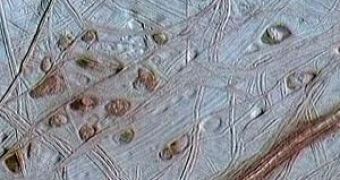The thought of a cold ocean covered by an extremely thick crust of ice (some scientific theories even estimate it to measure over 100 km in thickness) doesn't really do much for the idea of the moon's supporting even the most elementary forms of life. But a new study suggests that the premises of this theory may not be entirely accurate, which renews the hopes of finding life on icy moons like Europa or Saturn's Enceladus.
The patterns and characteristics of Europa's surface have long since led scientists to believe that there is a vast planetary ocean of liquid water lying underneath. In order to remain liquid over eons, this water needs to be heated in some way, and experts suggest that tidal heating could be generated by Jupiter's gravitational tugs forced on the moon's core. As Europa gets closer or farther from the large gaseous planet during its orbit, the gravity deforms its nucleus and releases heat via friction.
But the new research by Robert Tyler from the University of Washington in Seattle indicates that a faint tilt of the moon's spinning axis in relation to its orbital plane may determine the occurrence of swirls in the water beneath the crust that could provide much more heat than the tidal heating process. Added to the amount generated by the flexing of the moon's core, Europa's heat could prove to be more than enough in order for us to conclude that the ice crust is actually thinner than previously anticipated.
This conclusion, which is also valid in the case of Enceladus, boosts the ideas related to the presence of life in the ocean. It means that it is easier for the supply of oxidizing chemicals required by the metabolism process to reach its intended destination and recipients. These chemicals are supposedly generated on the lunar surface as the Sun's ultraviolet rays come in contact with the ice. "The thinner the ice is, the more likely that the surface can communicate with the ocean," explains Terry Hurford from NASA's Goddard Space Flight Center in Greenbelt, Maryland, cited by New Scientist.

 14 DAY TRIAL //
14 DAY TRIAL //